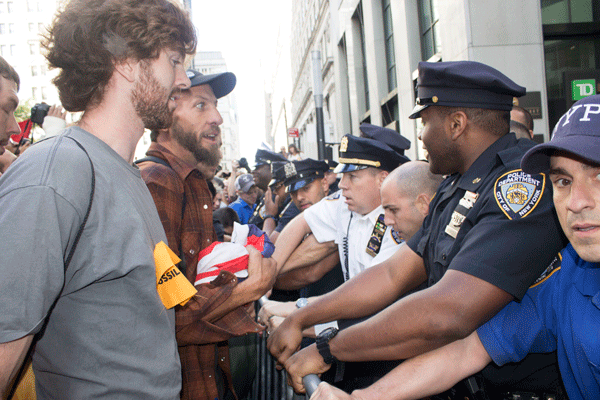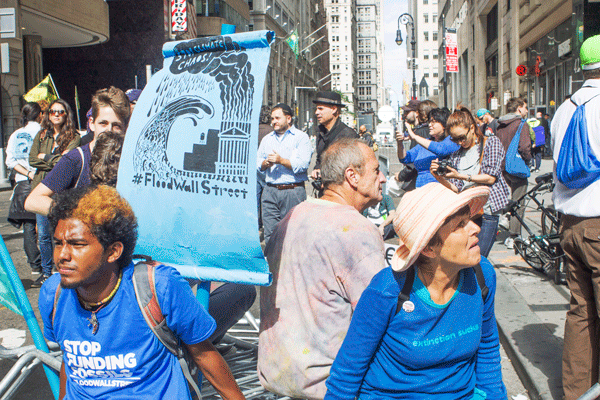
About 100 environmentalist demonstrators were arrested Downtown Monday, the day after the larger climate change rally in Midtown.
BY ZACH WILLIAMS | In response to rising sea levels and the other effects of climate change, more than 100 activist groups converged in Lower Manhattan on Sept. 22 to promote environmental justice as part of what they call Flood Wall Street.
The N.Y.P.D. pre-emptively blocked streets leading to the New York Stock Exchange, but about 1,000 activists succeeded in blocking Broadway for about eight hours at its intersection with Morris St. before extending the demonstration to include the intersection with Wall St. as well.
Many chanted: “People gonna rise like water. We’re gonna calm this crisis down. I hear the voice of my great granddaughter saying shut down Wall. St. now.”
In contrast to many past protests, N.Y.P.D. officers largely left the demonstrators alone while at the same time preventing them from penetrating further into the Financial District. Some demonstrators suspected that Mayor Bill de Blasio was behind the surprisingly reserved police presence.
“I think people seem happy and engaged. The police don’t seem to be too bossy,” said Joanna Burgess, a Battery Park City resident and supportive observer of the protest.
She said she saw neighborhood residents that morning seemingly dressed for Flood Wall Street. In B.P.C., support for Flood Wall Street is tied to location, she joked. “I think it depends what floor you live on.”
About 100 arrests — including an activist dressed as a polar bear — were made at about 7 p.m. after police moved in to clear the street, according to activists.
The event followed the People’s Climate March the day before which drew tens of thousands of activists, political leaders and celebrities to Midtown. Most involved with Flood Wall Street took part in that demonstration, some remaining in town one more day in order to participate in direct action against the financial industry which they said enables a global system of inequality as well as global warming itself.
“I’m very concerned about climate change and Wall St. is part of the problem. This is where the financing comes from for oil and pipeline extraction so we have to convince Wall St. to solve the climate problem,” said Cara Jennings, a Florida resident who came to NYC for the protests along with her toddler.

The group assembled in the morning at Battery Park to the tunes of the Rude Mechanical Orchestra, a local marching band. Before moving to Broadway, speakers linked social, political and economic inequality with the dangers of rising sea levels. Activist Naomi Klein told the crowd that the consequences of climate change must continue to inspire activists who came together three years ago for Occupy Wall Street.
“We are powered by the knowledge that the same system of short-term profit and de-regulated greed that deepens inequality and forecloses on homes is the very same system that is foreclosing on our collective home,” Klein said. “We never went away, we were organizing in our communities and now we are back with the power of water behind us.”
At about 11:45 a.m. they left the park via the intersection of Bridge and State Sts. and began marching to the Charging Bull at the northern end of Bowling Green. Upon arriving there, they found the path towards Wall St. blocked by the N.Y.P.D. While activists originally planned to stage a sit-in in front of the stock exchange, they improvised by doing so on Broadway instead.
Several vehicles would be caught within the critical mass for at least an hour before being let through.
“I didn’t plan on it, but it’s a good cause,” said Sean Vander from an automobile stalled at the intersection of Morris St. and Broadway just a few doors down from his destination at 25 Broadway.
Residents trying to enter Wall St. were told by police to walk several blocks north in order to go home.
As the sit-in continued, some activists grew weary with the tedium of occupation. Their numbers dwindled by about half by the late afternoon hours. Scuffles with police broke out when some protesters tried to swarm the N.Y.P.D. defense of Wall St. Police pushed back, smacked hands holding onto metal crowd control barriers and pepper-sprayed several protesters and a journalist before the situation settled down.
Demonstrators for the most part remained seated, discussing environmental issues amongst themselves. Later, some would draw chalk doodles on the street and play soccer. One demonstrator watching a game said that such activities promote more free usage of public space within a city known for its consumer culture.
“This is a space we don’t see relaxation very often,” said Jason who declined to give a last name. “That creates an energy that is helpful.”
But some protesters, and onlookers, said hours of sitting on Broadway were not productive enough to inspire more people to pressure Wall St.
“I thought it was supposed to be about economic inequality and laying some plans for some kind of coherent action… but there’s nothing being discussed here as far as I can see on a political level at all,” said Eric Rassi, a resident of E. 10th St.



































